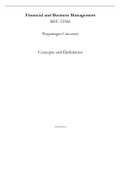Overig
Definitions and Concepts of Financial and Business Management
Definitions and Concepts of Financial and Business Management, for example: What is an Asset? What menas Depreciation? What is the Break Even Point? I also elaborate on different Costs (e.g. opportunity cost, variable costs, indirect costs, etc.). This document is very helpful in getting a basic un...
[Meer zien]




